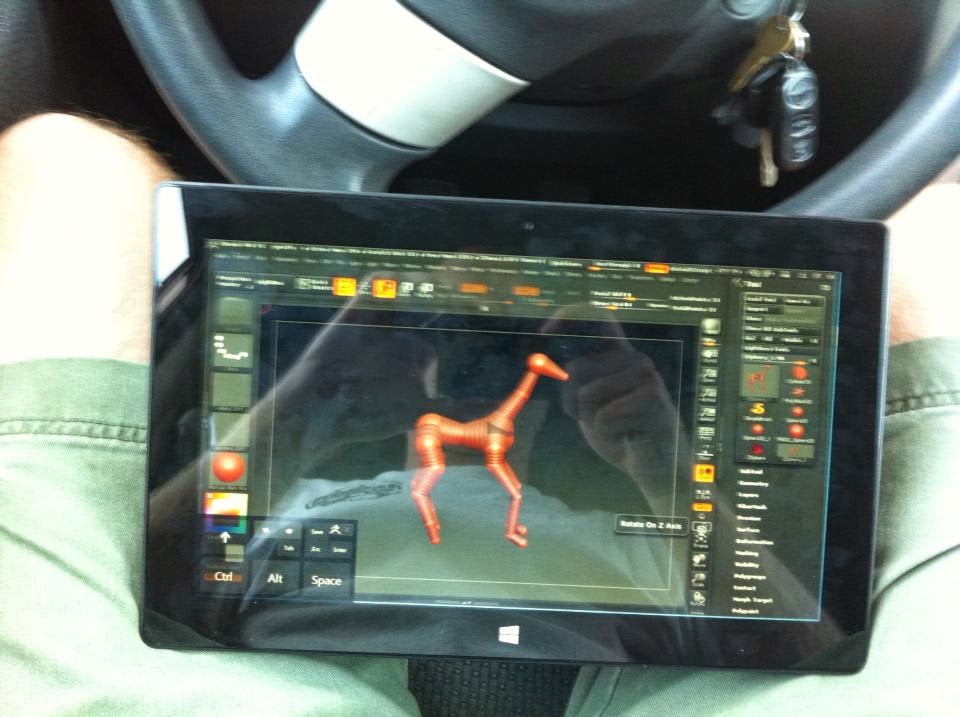Daily Art Battle
Fighting the daily battle to become a better artist.
Friday, July 4, 2014
Always fixing... it's NORMAL
A few days ago I was watching an anatomy sculpting video on www.digitaltutors.com. All of the training is very good and helpful, but every now and then, while sculpting, the tutor makes a comment about their mental process and struggles that is priceless. This was one of those times. What the tutor said totally destroyed another one of those long held beliefs that was holding me back and making art frustrating instead of fun.
As all ZBrush sculpting tutors do they emphasize working through the stages, from rough to detailed. In ZBrush especially each tutor emphasizes the need to start with a low resolution mesh and don't subdivide (move up to a higher level of detail) until you've gotten as much out of the current level as you can. This really applies to all art, drawing, sculpting, everything, start with a rough and work towards more detail. Don't move on until you've got the rough right. I've heard this 1000x. Got it.
The tutor was Lee Magalhaes. He was sculpting a head bust. He started with getting the head generally in good shape, tweaking the jaw, chin, etc. After several videos he would move up to a new subdivision level as expected.
After getting quite a bit into some detail he said something that blew me away.
He was working on some detail and realized that he wasn't happy with the chin and jaw, he fixed the jaw from the side but then it wasn't right from the front. Then he said "This is sculpting at it's most hectic. You're always moving, you're always tweaking, you're always doing something crazy, now you're changing and it doesn't look good and then you gotta fix it. It starts to look good and then you mess something else up. It's NORMAL, you don't have to worry about it. "
This blew me away and really really helped me. I had the idea in my mind that if I were sculpting and couldn't see that I got a large proportion off until later that it was because I just wasn't good enough to "be a real sculptor" yet. I figured that someday I'd get to the point where I would work through each stage, making it perfect (in short time) and move solidly onto the next never having to ever change what I had already done. But this isn't true. Even the experts can't always see some changes that need to be made until they are farther along in adding detail.
It was so good to hear that this is normal. That tells me that even though I have these problems, I don't have to overcome it to produce the art that I want. I don't have to obsess about it, worry about it, let it stop me.
I can be thankful that I was able to see that a change needed to be made fix it.
Sunday, June 1, 2014
Finding time for art while waiting
Making the most of fragmented time
Fragmented time, the little bits of time that I have in between activities or while waiting on something. Time that doesn't seem useful for much else except reading, checking Facebook, praying or relaxing (not that these can't be noble uses of that time). I used to dread these times, now they are like gold to me. I am always telling my wife that I will volunteer to be the one to drive our daughter to a practice because I know it means about 40 min in the car to be with my daughter plus hour or two of uninterrupted time for art. Sitting in a parking lot, or a nearby Barns & Nobles, it seems that I can get a lot done.
My setup:
 Hardware:
Hardware:Microsoft Surface Pro
Software:
SketchBook Pro
Pixologic ZBrush 4R6
This enables me to do digital art almost anywhere. If I were a traditional artist I would simply use a sketchbook or drawing kit and take it with me wherever I went.
Unusual times to do art that really work:
- While waiting for my daughter at her ballet practices.
- After dropping off my children at their school at 7:50am I have about 30 min before I have to leave for work. Not enough time to do much else as the traffic is horrible. So I park by some pine trees, put on some music, and do art for about a half an hour before going on to work.
- Before going to sleep each night I do at least one 30 second sketch. These can be extremely valuable when done with consistency. Often I find that I can't stop after just 30 seconds, but it's OK if I do. Sometimes I can't do it at night but then I do it in the morning.
I'll update this particular blog entry as I find more ideas for times and places to work on my art.
Subscribe to:
Comments (Atom)
